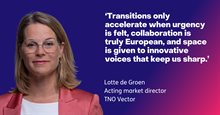Twenty-five years ago, Philips was in a convincing first place with R&D expenditures of over one billion euros. At that time, ASML was in second place with nearly a quarter of a billion euros. Now, a quarter of a century later, the roles have reversed. The same two companies still lead the list, but now ASML is in first place. In 2023, this company spent over 2.8 billion euros on R&D. Philips, the number two, spent a quarter of that amount: 700 million euros. And the third place? It goes to Booking.com, with420 million euros. Following are KPN and Janssen (part of Johnson & Johnson), with 307 million and293 million euros in R&D expenditures, respectively. For those who are more visually inclined, the bar chart clearly shows: ASML has built an impressive lead in R&D expenditures.
Machine Builders
The commonality between the number one and two? Both ASML and Philips focus on building machines. ASML produces highly advanced chip machines, while Philips is now primarily active as a supplier of health technology. In the 1980s, Philips was a very different company. Besides being a maker of consumer electronics, it was very active in the semiconductor industry. In fact, when ASML was founded in 1984, it was a joint venture of ASM and Philips. No one could have predicted that ASML would surpass Philips in R&D expenditures thirty years later.
Impressive Growth Curve
Since 2014, ASML has not only invested more money in research and development than Philips but has also surpassed every other company based in the Netherlands in this area. From 2016, this growth accelerated significantly. In cycling terms, it was as if an individual rider broke away from the leading group and quickly disappeared, turning into a dot on the horizon. Each year, they added another gear. This explains why ASML's R&D expenditures in 2023 were higher than those of the rest of the top ten combined. "ASML develops and builds extremely complex machines in a highly innovative industry where enormous amounts of money are involved worldwide. They have no choice but to invest more and more in R&D to maintain their lead," says Cor Jorna, business developer at TNO Vector.
Top 30 in a broader perspective
Vulnerability
'That ASML is doing so well is, of course, great, but the fact that a large part of the R&D expenditures in the Netherlands goes to machine building also makes us vulnerable in terms of innovation, 'emphasizes Marcel de Heide. As an economist at TNO Vector, he researches innovation policy. Since research and development can significantly strengthen companies' innovative power, he emphasizes the importance of higher R&D investments in his analyses.
'In many sectors, these expenditures are really lagging, which can cause us to become less innovative as a country in the long term and lose our global position in this area. This is something we at TNO are seriously concerned about. For example, when I look at the 30 companies that spend the most on R&D, I notice an increasing concentration: the top 5 accounts for almost 30 percent of the total R&D expenditures.'
Big Difference from 1999
'And that concentration is only increasing,' adds Jasper van Kempen. At TNO Vector, he makes economic analyses and shows a picture where the concentration of R&D expenditures is clearly visible. 'You see that these expenditures are largely made by companies active in the Eindhoven area. Notably, of the companies that were in the top 10 twenty-five years ago, only four still belong to the R&D leaders in 2023: ASML in first place, Philips in second, and Thales and Canon in ninth and tenth places, respectively. In between are Booking.com, KPN, Janssen, NXP, Daf Trucks, and VDL Group. This is a completely different picture from the top 10 of 1999, which prominently featured companies like Shell, Unilever, and Tata Steel.'
What Does R&D Yield?
Of course, companies do not do R&D for fun. At ASML, research and development are necessary to develop new lithography technologies that enable increasingly advanced microchips. Without R&D, they would not have been able to develop chip machines that use extreme ultraviolet light and would not have had such a significant lead over other parties. 'R&D helps create more value, especially in the long term,' says Jorna. 'Spending less on R&D will probably not have a major impact in the short term, but such a decision is likely to have a negative effect on your future competitive position. It is important to realize that doing something for the future is inherently uncertain, but research and development often form an important basis for growth.'
Not Betting on One Horse
The fact that we are very good at machine building in the Netherlands and invest the most R&D money in it creates a flywheel effect. Growing revenues lead to extra budget for research and development, often resulting in innovative solutions. These innovations generate more money, allowing even more to be invested in R&D. And so on. But what if the global market for chip machines and high-tech equipment cools down quickly? Then we do not have another sector in the Netherlands where comparable R&D efforts take place. 'That ASML is doing so well is, of course, great, but the fact that this company invests the most in R&D by far also makes our country vulnerable in terms of innovation,' says De Heide. 'Of course, the enormous growth of ASML is a very nice success story,' Jorna wants to emphasize. 'As a country, you should only encourage that. But indeed, it is also good to look at where there are other growth opportunities.'
Targeted Policy Helps
'In Belgium and Germany, they have spread the risks better,' says Van Kempen, who has recently researched how these two neighboring countries have achieved their R&D goals. 'For example, if you look at Belgium, you see that they have cleverly built on the already existing pharmaceutical industry. A crucial moment was the establishment of the Flemish Institute for Biotechnology in 1995. This fit with the strategy launched at the time to strengthen the biotechnology sector for a period of thirty years. This focus on biotech, combined with attractive tax schemes, has led to a thriving ecosystem of start-ups, knowledge institutions, and large pharmaceutical companies. The success of this approach is evident from the fact that 29 of the 30 largest pharmaceutical companies now have a presence in Belgium. A good example of a targeted long-term policy that builds on existing strengths and how such a strategy can lead to an internationally leading sector. And 'targeted' is indeed the key word.'
3 Percent of GDP
For comparison: in 2000, the EU countries agreed to invest 3 percent of GDP in R&D. In the Netherlands, we are still far below that: currently, we are at 2.08 percent. Meanwhile, Germany and Belgium have been above 3 percent for years. Germany's goal is 3.5 percent, and the new Flemish government in Belgium has included in their coalition agreement that 5 percent is the new goal. In short, in terms of R&D investments, it looks like the gap between the Netherlands and the two neighboring countries is only getting bigger.
Important Strategic Questions
'An ambitious long-term approach would also be a good strategy for the Netherlands,' says De Heide. 'To begin with, it would help if we better understood the effects of fiscal policy and subsidies in the context of the total mix of instruments that support research by and for companies. In which sectors do stimulating measures contribute more to larger private investments in R&D? Which parties benefit the most from this? And to what extent does this align with the long-term innovation policy for the Netherlands?'
'But also: what does the business climate look like?' adds Jorna. 'How much regulatory pressure do companies experience? And to what extent are R&D and innovation stimulated?'
'Yes, exactly,' agrees De Heide. 'By asking such questions, new insights will undoubtedly emerge that can help strengthen our country's innovative power.'





